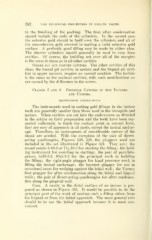Page 586 - My FlipBook
P. 586
282 THE TECHNIC.VL PROCEDUEES IN FILLING TEETH.
to the finisliing of the packing. The final after condensation
should include the ends of the cylinders. In the second case
the cohesive gold should be built over the cylinders and all of
the non-cohesive gold covered in making a solid cohesive gold
surface. A perfectl}' good filling may be made by either plan.
The shorter cylinders should generally be used in veiy deep
cavities. Of course, the building out over all of the margins
is the same in these as in all other cavities.
Other pit and fissure cavities. The other cavities of this
class, the buccal pit cavities in molars and the lingual pit cavi-
ties in upper incisors, require no special mention. The technic
is the same as for occlusal cavities, with such modifications as
are caused by the difference in the access.
Classes 3 and -i. Proximal Cavities in the Incisors
AND Cuspids.
ILLUSTR.\TIOSS : FIGURES 365-374.
The instruments used in making gold fillings in the incisor
teeth are generally smaller than those used in the bicuspids and
molars. When cavities are cut into the embrasures as directed
in the article on their preparation and the teeth have been sep-
arated sufficiently to finish the contact point in correct form,
they are easy of approach in all parts, except the incisal anchor-
age. Therefore, no instruments of considerable curves of the
shank are needed. With the exception of the pair of direct-
acting quadrangles. Figures 328, 329, the pluggers used are
included in the set illustrated in Figure 324. They are: the
round points 5-10-3 or Ti/o-lO-S for starting the filling; the hold-
ing instrument for assisting in starting; the pair of parallelo-
grams, 5x10-3-3, 10x5-3-3 for the principal work in building
the filling; the right-angle plugger for hand pressure work in
filling the incisal anchorage; the bayonet plugger for use in
occasional cases for wedging against the labial wall ; the Varney
foot plugger for after condensation along the labial and lingual
walls ; the pair of direct-acting quadrangles for after condensa-
tion along the gingival wall.
Case. A cavity in the distal surface of an incisor is pre-
pared as shown in Figure 365. It would be possible to do the
l)rin('i))al ])art of the work of making such a filling either from
the lingual or from the labial approach. The most general rule
should be to use the labial approach because it is most con-
venient.


